Thunderbirds
- Official name:
- U.S. Air Force Air Demonstration Squadron
- Date:
- May 1953 - present
- Areas Of Involvement:
- airplane
- formation flying
- F-16
News •
Thunderbirds, U.S. Air Force fighter aircraft squadron that performs aerobatics at air shows and other events throughout the United States and around the world. The squadron includes six pilots, who fly with the team for two years (half the pilots are replaced each year), and some 135 support personnel. The squadron, which practices and performs 50 weeks a year, is stationed at Nellis Air Force Base in Las Vegas.
The team officially began in May 1953 as the 3600th Air Demonstration Unit at Luke Air Force Base in Arizona. Following the Korean War, its mission was to show the American public the safety, reliability, and maneuverability of jet-engine aircraft, which were relatively new at the time. The Thunderbirds have performed in all 50 states and dozens of countries in thousands of formation-flying demonstrations, which serve as a recruiting tool for the U.S. Air Force and create goodwill for the American government.
Except for the years immediately following the oil embargo by the Arab members of OPEC in 1973, the team has always used combat-capable fighters for its performances. These have included the Republic F-84G Thunderjet (1953–54), the Republic F-84G Thunderstreak (1955), the North American F-100 Super Sabre (1956–68), the Republic F-105B Thunderchief (1964), and the McDonnell Douglas F-4 Phantom (1969–73). From 1974 to 1981, in an effort to save fuel costs, the Thunderbirds flew the Northrop T-38 Talon, the world’s first supersonic flight trainer. Following the fatal incident in January 1982 known as the Diamond Crash, in which the lead aircraft and three others were destroyed during a training flight, the team switched back to the latest combat aircraft. Since then it has employed the Lockheed Martin F-16A Fighting Falcon (1983–91) and the Lockheed Martin F-16C Fighting Falcon (1992 to the present).
The team’s performance is divided into two main formation-flying demonstrations: all six airplanes flying in a tight delta (triangle) formation, alternating with maneuvers in which four of the airplanes fly in a diamond formation while the remaining two airplanes perform various solo stunts. When the aircraft are flying in close formation, the separation between them can be as little as 1.5 feet (0.5 metre).
The Thunderbirds added its first female team pilot, Capt. Nicole Malachowski, in June 2005, and its first female solo pilot, Capt. Samantha Weeks, in 2006.

















